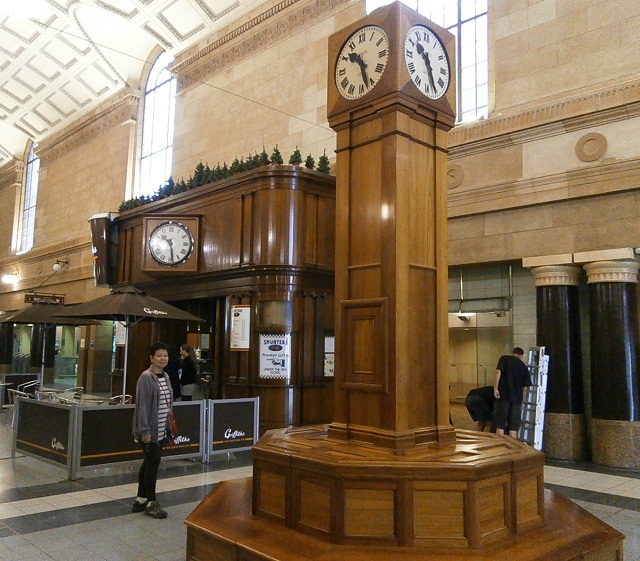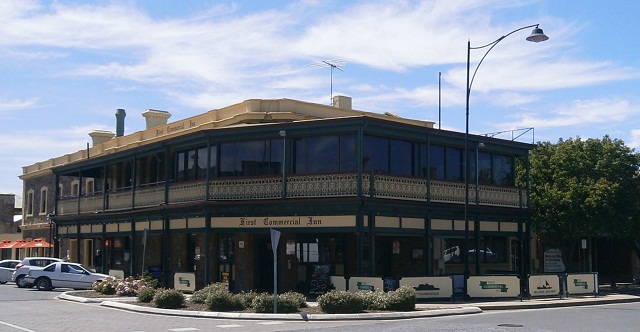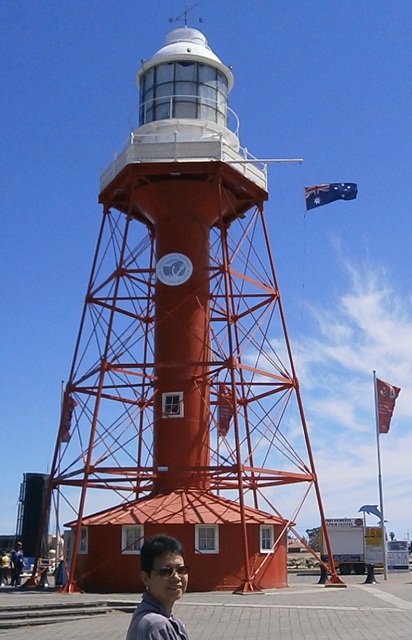Filtered By: Lifestyle
Lifestyle
The red lighthouse of Port Adelaide
Text & photos by ALICE SUN-CUA
Port Adelaide, South Australia
My husband Alex and I were in Adelaide, enjoying the cool and sunny spring weather of South Australia. We were staying in one of the small but very comfortable B&Bs along South Terraces, and the day before, we learned that all trams from King Williams St. (only a short walk away) to the Adelaide Entertainment Center in the city were free. That morning we planned to visit Port Adelaide, an old historic town only 30 minutes by train from the city. Alex had bought an all-day ticket for trains and buses, at A$9.50 for each of us.
The tram’s waiting shed had clear fibreglass walls, probably to protect the commuters from icy winds during winter. That morning though, the sun was shining, and a soft breeze was blowing. A cheery “ding dong” announced the arrival of the tram, and Alex and I made sure we were going in the correct direction.
We passed through the commercial heart of the city, until we reached the main railway station. Make that “Railway Station.” We stood in front of its entrance for some time, as we realized that the edifice was a historical building. It opened in 1856, with the governor of South Australia and other dignitaries going on the inaugural train ride to Port Adelaide for lunch.
 Since then, the rail station has had many renovations and refurbishment, but the old-world look remained. Inside, the waiting room was wide and airy, with ceilings three storeys high and balconies. A small museum chronicled the history of South Australia’s train system, with many framed sepia photos. There were quaint coffee shops too, with shiny wooden panels. A large clock at the center chimed the hour. The huge hall looked clean and unhurried; that is, until a train arrived, spilling out commuters onto the concourse and out into the hall.
Since then, the rail station has had many renovations and refurbishment, but the old-world look remained. Inside, the waiting room was wide and airy, with ceilings three storeys high and balconies. A small museum chronicled the history of South Australia’s train system, with many framed sepia photos. There were quaint coffee shops too, with shiny wooden panels. A large clock at the center chimed the hour. The huge hall looked clean and unhurried; that is, until a train arrived, spilling out commuters onto the concourse and out into the hall.
We were quite early for our 10:43 AM trip, so we had time to look around and enjoy the heritage-listed place. Above the rail station was a casino, to further utilize the building, and a Hyatt Regency Hotel at its northern portion. The Adelaide Convention Center, with its Exhibition Hall and offices, were built on the southern and central part of the railway station.
The train left on time, and probably because it was a weekday, we had the sweet-smelling and relatively new train to ourselves. When we arrived at Port Adelaide, we had to find our way to the exit as the train station was on an elevated track.
We walked to the Commercial Road, and saw many heritage buildings. This included the Port Adelaide Visitor Information Center, which was in a two-storey, brick building built in 1850; it used to house the Customs, Police, and Courts offices. Just outside was a white marble statue of Lady “Justice” standing on a tall, granite base, with the words “Workers’ Monument.”

All around the area it seemed were heritage houses, especially along St. Vincent Street: the Port Admiral Hotel (1849), said to be the oldest building in The Port, was the original “Railway Hotel.” Old warehouses constructed in 1865 and made of stone glinted under the sun. Because Port Adelaide used to be the only access to the sea for Adelaide, these warehouses played important roles in its early commercial life, when sea trade was at its busiest. We saw another Victorian-looking building at the corner of St. Vincent Street and Lipson Street: this was the “newer” Railway Hotel, built in 1856, the year when the Adelaide to Port Adelaide railway was completed.
Further on were The St. Vincent Chambers and the Royal Arms Hotel, built in the late 1800s, with verandas and lacy iron grills. The First Commercial Inn, a large hotel built in 1841, looked unchanged through the years. The sun was getting higher now, and we began to feel warm. Alex suggested that we go over and see the source of Port Adelaide’s logo, the red lighthouse.
 A fresh breeze was coming up as we walked towards the river, cooling the air. The sky was cerulean, and wisps of white clouds were stark against the blue. And, at the end of the road, silhouetted against the sky was the lighthouse, in all its red glory, with a white top and Australian pennants fluttering in the wind at the guy wires at the sides. It was originally built in 1869, at the entrance to the Port River. Through the years however, the river silted over, and Port Adelaide slowly lost its sea trade because the water became too shallow for larger merchant vessels to dock. The lighthouse was re-erected in South Neptune Island in 1901, further dismantled in 1985, and placed on the present site in 1986.
A fresh breeze was coming up as we walked towards the river, cooling the air. The sky was cerulean, and wisps of white clouds were stark against the blue. And, at the end of the road, silhouetted against the sky was the lighthouse, in all its red glory, with a white top and Australian pennants fluttering in the wind at the guy wires at the sides. It was originally built in 1869, at the entrance to the Port River. Through the years however, the river silted over, and Port Adelaide slowly lost its sea trade because the water became too shallow for larger merchant vessels to dock. The lighthouse was re-erected in South Neptune Island in 1901, further dismantled in 1985, and placed on the present site in 1986.
The lighthouse could be climbed and inspected. The view of the river and the riverside buildings across it was encompassing from the tower. The curve of the water and the boats that offer blue-nosed dolphin watching were at the quay, waiting for passengers. A group of schoolchildren, about 20 of them, were seated at a small table beside the lighthouse. They had their lunch boxes with them, and Teacher was telling them to eat their sandwiches slowly.
There were many museums to explore in the town: the National Railway Museum, Boer War Memorial Musuem, and of course, the South Australian Maritime Museum. I wanted to see some of the old ships and tugboats, which were moored at The Waterfront area. Port Adelaide may not have the large, boisterous crowds and upscale shops, but it had so much to offer in a more quiet and historical way. – YA, GMA News
My husband Alex and I were in Adelaide, enjoying the cool and sunny spring weather of South Australia. We were staying in one of the small but very comfortable B&Bs along South Terraces, and the day before, we learned that all trams from King Williams St. (only a short walk away) to the Adelaide Entertainment Center in the city were free. That morning we planned to visit Port Adelaide, an old historic town only 30 minutes by train from the city. Alex had bought an all-day ticket for trains and buses, at A$9.50 for each of us.
The tram’s waiting shed had clear fibreglass walls, probably to protect the commuters from icy winds during winter. That morning though, the sun was shining, and a soft breeze was blowing. A cheery “ding dong” announced the arrival of the tram, and Alex and I made sure we were going in the correct direction.
We passed through the commercial heart of the city, until we reached the main railway station. Make that “Railway Station.” We stood in front of its entrance for some time, as we realized that the edifice was a historical building. It opened in 1856, with the governor of South Australia and other dignitaries going on the inaugural train ride to Port Adelaide for lunch.
 Since then, the rail station has had many renovations and refurbishment, but the old-world look remained. Inside, the waiting room was wide and airy, with ceilings three storeys high and balconies. A small museum chronicled the history of South Australia’s train system, with many framed sepia photos. There were quaint coffee shops too, with shiny wooden panels. A large clock at the center chimed the hour. The huge hall looked clean and unhurried; that is, until a train arrived, spilling out commuters onto the concourse and out into the hall.
Since then, the rail station has had many renovations and refurbishment, but the old-world look remained. Inside, the waiting room was wide and airy, with ceilings three storeys high and balconies. A small museum chronicled the history of South Australia’s train system, with many framed sepia photos. There were quaint coffee shops too, with shiny wooden panels. A large clock at the center chimed the hour. The huge hall looked clean and unhurried; that is, until a train arrived, spilling out commuters onto the concourse and out into the hall.We were quite early for our 10:43 AM trip, so we had time to look around and enjoy the heritage-listed place. Above the rail station was a casino, to further utilize the building, and a Hyatt Regency Hotel at its northern portion. The Adelaide Convention Center, with its Exhibition Hall and offices, were built on the southern and central part of the railway station.
The train left on time, and probably because it was a weekday, we had the sweet-smelling and relatively new train to ourselves. When we arrived at Port Adelaide, we had to find our way to the exit as the train station was on an elevated track.
We walked to the Commercial Road, and saw many heritage buildings. This included the Port Adelaide Visitor Information Center, which was in a two-storey, brick building built in 1850; it used to house the Customs, Police, and Courts offices. Just outside was a white marble statue of Lady “Justice” standing on a tall, granite base, with the words “Workers’ Monument.”

All around the area it seemed were heritage houses, especially along St. Vincent Street: the Port Admiral Hotel (1849), said to be the oldest building in The Port, was the original “Railway Hotel.” Old warehouses constructed in 1865 and made of stone glinted under the sun. Because Port Adelaide used to be the only access to the sea for Adelaide, these warehouses played important roles in its early commercial life, when sea trade was at its busiest. We saw another Victorian-looking building at the corner of St. Vincent Street and Lipson Street: this was the “newer” Railway Hotel, built in 1856, the year when the Adelaide to Port Adelaide railway was completed.
Further on were The St. Vincent Chambers and the Royal Arms Hotel, built in the late 1800s, with verandas and lacy iron grills. The First Commercial Inn, a large hotel built in 1841, looked unchanged through the years. The sun was getting higher now, and we began to feel warm. Alex suggested that we go over and see the source of Port Adelaide’s logo, the red lighthouse.
 A fresh breeze was coming up as we walked towards the river, cooling the air. The sky was cerulean, and wisps of white clouds were stark against the blue. And, at the end of the road, silhouetted against the sky was the lighthouse, in all its red glory, with a white top and Australian pennants fluttering in the wind at the guy wires at the sides. It was originally built in 1869, at the entrance to the Port River. Through the years however, the river silted over, and Port Adelaide slowly lost its sea trade because the water became too shallow for larger merchant vessels to dock. The lighthouse was re-erected in South Neptune Island in 1901, further dismantled in 1985, and placed on the present site in 1986.
A fresh breeze was coming up as we walked towards the river, cooling the air. The sky was cerulean, and wisps of white clouds were stark against the blue. And, at the end of the road, silhouetted against the sky was the lighthouse, in all its red glory, with a white top and Australian pennants fluttering in the wind at the guy wires at the sides. It was originally built in 1869, at the entrance to the Port River. Through the years however, the river silted over, and Port Adelaide slowly lost its sea trade because the water became too shallow for larger merchant vessels to dock. The lighthouse was re-erected in South Neptune Island in 1901, further dismantled in 1985, and placed on the present site in 1986.The lighthouse could be climbed and inspected. The view of the river and the riverside buildings across it was encompassing from the tower. The curve of the water and the boats that offer blue-nosed dolphin watching were at the quay, waiting for passengers. A group of schoolchildren, about 20 of them, were seated at a small table beside the lighthouse. They had their lunch boxes with them, and Teacher was telling them to eat their sandwiches slowly.
There were many museums to explore in the town: the National Railway Museum, Boer War Memorial Musuem, and of course, the South Australian Maritime Museum. I wanted to see some of the old ships and tugboats, which were moored at The Waterfront area. Port Adelaide may not have the large, boisterous crowds and upscale shops, but it had so much to offer in a more quiet and historical way. – YA, GMA News
Tags: travelogue, adelaide
More Videos
Most Popular




